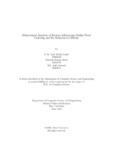| dc.contributor.advisor | Alam, Md. Golam Rabiul | |
| dc.contributor.author | Labib, S. M. Fazle Rabby | |
| dc.contributor.author | Achol, Fahmida Zaman | |
| dc.contributor.author | Jawwad, Md. Aqib | |
| dc.date.accessioned | 2023-12-10T05:20:08Z | |
| dc.date.available | 2023-12-10T05:20:08Z | |
| dc.date.copyright | 2023 | |
| dc.date.issued | 2023-06 | |
| dc.identifier.other | ID 19301049 | |
| dc.identifier.other | ID 19101470 | |
| dc.identifier.other | ID 19301017 | |
| dc.identifier.uri | http://hdl.handle.net/10361/21938 | |
| dc.description | This thesis is submitted in partial fulfillment of the requirements for the degree of Bachelor of Science in Computer Science, 2023. | en_US |
| dc.description | Cataloged from PDF version of thesis. | |
| dc.description | Includes bibliographical references (pages 48-51). | |
| dc.description.abstract | The purpose of this research is to determine what influences people to order food online and the intensity of ordering as well as to see if there is any correlation between online food ordering and obesity among the people of Bangladesh. We conduct an online questionnaire survey analyzing data from 343 participants aged 16-30 residing in Bangladesh. We use Ordinary Least Squares, Decision Tree, and Random Forest to determine the factors influencing customers’ decision to order food online. The most influential factors are impulsive decision (mean = 2.01, OLS coefficient = 0.90), convenience of ordering (mean = 2.98, OLS coefficient = 0.65), variety of options available (mean = 2.98, OLS coefficient = 0.15), and promotional offers and discounts (mean = 2.60, OLS coefficient = 0.33). Then, we conduct statistical analyses to determine the correlation between obesity and the intensity of online food ordering. We find a weak positive relationship (p-value = 2.43−7 , coefficient = 0.28). We classify frequent users of OFO by using classifiers such as Logistic Regression, Naive Bayes, Decision Tree Classifier, Random Forest Classifier, Gradient Boosting Machine and K-Nearest Neighbors, where we find Random Forest to perform the best with an accuracy of 81%. Customer segmentation using K-Means clustering reveals that infrequent orders perceive OFO services as expensive, while frequent customers find the food lacking in nutrition. Several Chi-Squared Tests are conducted, revealing significant associations. Firstly, tech savviness is strongly related to perception of OFO services as user-friendly (p < 0.001). Secondly, individuals leading busy lives tend to make impulsive decisions (p < 0.001). Lastly, affordability of OFO services correlates with ordering behavior driven by promotional offers and discounts (p < 0.001). These insights, along with the developed prediction models and customer segmentation, contribute to a deeper understanding of consumer behaviour in an increasingly digitalized food landscape. | en_US |
| dc.description.statementofresponsibility | S. M. Fazle Rabby Labib | |
| dc.description.statementofresponsibility | Fahmida Zaman Achol | |
| dc.description.statementofresponsibility | Md. Aqib Jawwad | |
| dc.format.extent | 54 pages | |
| dc.language.iso | en | en_US |
| dc.publisher | Brac University | en_US |
| dc.rights | Brac University theses are protected by copyright. They may be viewed from this source for any purpose, but reproduction or distribution in any format is prohibited without written permission. | |
| dc.subject | Online food ordering | en_US |
| dc.subject | Obesity | en_US |
| dc.subject | Statistical analysis | en_US |
| dc.subject | Prediction models | en_US |
| dc.subject | Customer segmentation | en_US |
| dc.subject | Hypothesis testing | en_US |
| dc.subject.lcsh | Statistics--Data processing | |
| dc.subject.lcsh | Statistics--Computer programs | |
| dc.title | Behavioural analysis of factors influencing online food ordering and its relation to obesity | en_US |
| dc.type | Thesis | en_US |
| dc.contributor.department | Department of Computer Science and Engineering, Brac University | |
| dc.description.degree | B.Sc. in Computer Science and Engineering | |

